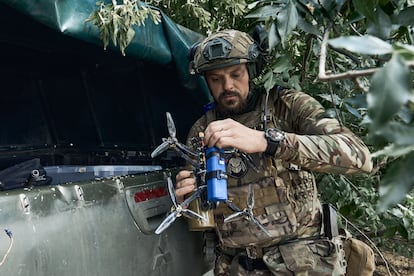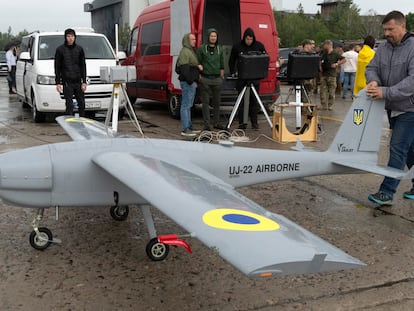Ukraine places trust in White House to prevent Musk pulling plug on Starlink comms for the Armed Forces
The Ukrainian military has few alternatives to the SpaceX communication system but concerns have been raised after the billionaire acknowledged he had refused to sanction its use over Crimea

Ukraine’s existence depends to a large extent on Elon Musk. The satellite connection provided by his company SpaceX is “the backbone of Ukraine’s military communications,” as the billionaire himself said at a conference in Paris this month. Thousands of antennas connected to Musk’s Starlink satellite data transmission service are used by every Ukrainian unit on the front lines. If these were to stop working, Kyiv’s defenses would collapse.
The country’s security therefore depends on Musk’s own agenda — he has on occasion been conciliatory toward Russia — but also on his power to unilaterally cut Starlink coverage on the battlefield. Kyiv is seeking alternatives for its military communications, and has proven that it has them, but Volodymyr Zelenskiy’s government acknowledges that it is impossible to disengage entirely from Musk. Ukraine’s primary hope is that the U.S. government will guarantee SpaceX will not leave them in the lurch.
There are around 42,000 Starlink data transmission terminals in Ukraine. Nine months ago, there were 23,000, according to Mikhail Fedorov, Ukraine’s Minister of Digital Transformation. Most are used by the military. “Starlink is indeed the blood of our entire communications infrastructure now” Fedorov told The New York Times in July. The terminals are mostly purchased by private donors, but also by governments allied with Kyiv. There are forums on social networks that provide tutorials on how to use them and advice on where they can be acquired at the best price. If a terminal is purchased in Spain, for example, the owner can transfer the address to Ukraine.
Starlink antennas are used in multiple ways at the front: a platoon can use them to communicate with their families and gain access to mobile applications, but above all they are used for military purposes. The network allows orders to be disseminated and provides the location of enemy coordinates in applications used by the Armed Forces; the antennas are also embedded in assault vehicles to communicate with command posts and, above all, receivers are installed in attack drones to maintain connection with the aircraft over long distances.
“Starlink has been a phenomenal asset for Ukraine. It is easy to transport, in a backpack; vehicles with large antennas are no longer necessary,” British Air Marshal John Stringer explained in an August 31 paper published by RUSI, the UK’s leading defense and security think tank. “Ukraine has shown that when it comes to military assets from space, from imagery to communications, what was only available to a few [countries] a few years ago can now be available to all,” the senior U.K. Air Force officer added.
A study carried out this month by the European Council on Foreign Relations (ECFR) made the same point: “The rapid deployment of Starlink terminals in Ukraine demonstrates the advantages of commercial systems compared to military ones. They are inexpensive compared to military and government satellites, and are faster to produce and install.” In Ukraine, the cost of the equipment is €560 ($600), plus €70 ($75) per month for the service.

Cutting the signal
However, over the last year, alarm bells have been ringing about the risks of Musk providing the “backbone” of the Ukrainian military’s communications. Since the November 2022 counteroffensive that liberated half of Kherson province, there have been warnings from senior commanders that Starlink’s satellite connection could suddenly disappear in offensive operations, putting the lives of military personnel at risk. SpaceX President Gwynne Shotwell confirmed last February that the company had mechanisms in place to cut Starlink’s signal.
Shotwell stressed that Starlink “was never meant to be weaponized.” Responding to reports that the Ukrainian military was using Starlink to control drones, Shotwell said: “There are things that we can do to limit their ability to do that; there are things that we can do, and have done.” Kyrylo Budanov, the head of Ukrainian military intelligence, did not mince his words during a September 9 conference in Kyiv: “Starlink has played an essential role, and will continue to play an essential role, particularly in drone communication.”
Budanov said he doubted that it is Musk alone who will make the decision to “push a button” and pull the plug on Starlink. But the billionaire himself confirmed on September 8 that on at least one occasion he has intervened directly. The Ukrainian government asked Musk to activate the connection of satellites over Crimea in order to be able to carry out a drone strike against the Russian Black Sea fleet, but he refused: “If I had agreed to their request, then SpaceX would be explicitly complicit in a major act of war and conflict escalation,” he said.
SpaceX began marketing the Starlink internet service in 2021, progressively expanding the countries in which it could be used. In February 2022, when the invasion of Ukraine began and Russia implemented a strategy of cutting off telephony in the occupied territories and on the front lines, Kyiv asked Musk to activate Starlink in Ukraine, which he agreed to. Musk and Shotwell have reiterated that the service was activated for civilian use, although over time, as they have publicly admitted, they assumed that it could also be used for military communications, but not for offensive actions.
The line of what is and is not allowed is fickle. In the Starlink Facebook group for Ukraine there are multiple examples. In a recent comment, a soldier from a battalion of the Territorial Defense Forces explained that he had obtained a terminal in Spain but that, when transferring the new address to Ukraine, he had indicated that it was for a military unit and the supplier had refused to send it, claiming that the contract with Starlink specified that it could only be used for civilian use. Other forum members criticized the soldier for providing too much information.
There was an emergency request from government authorities to activate Starlink all the way to Sevastopol.
— Elon Musk (@elonmusk) September 7, 2023
The obvious intent being to sink most of the Russian fleet at anchor.
If I had agreed to their request, then SpaceX would be explicitly complicit in a major act of war and…
SpaceX geofencing
Musk’s confirmation that he had refused to sanction the use of Starlink in Crimea for an offensive action sparked debate on the Ukraine Facebook group. “It is impossible to win this war with other people’s weapons,” said an officer serving in the Armed Forces, who also detailed one of the measures that SpaceX has to deactivate the service — geofencing — which consists of disabling the use of terminals in a given territory. “There is nothing to be done about this,” explained the officer, S. D. “Each terminal has its IP address and it is linked to its location. If the device crosses the boundary, it disconnects from the network.”
Alternatives to Starlink are scarce, but they do exist, as confirmed to EL PAÍS by Ukrainian Armed Forces Captain Victor Tregubov. The proof of this is that periodically there are Ukrainian attacks with drone bombs on Russian territory and in Crimea, areas where SpaceX does not operate. The technology Kyiv uses in these cases is a state secret. “Of course there are alternatives, there are projects underway in the United States and Ukraine, and we may be helped by governments of allied countries,” Tregubov says, “but without Starlink, everything would be much more difficult.”
There are 10 major commercial companies offering satellite internet, but none can compare to SpaceX’s quality of service, price, and widespread usage. The Swedish company Satcube donated 100 terminals this year, which are also easy to transport and set up, but the size of the company makes it unfeasible for it to replace Starlink.
The main hope is that the U.S. government will rein in Musk, a supporter of ending the war by conceding part of Ukraine to Russia. The founder of SpaceX himself has admitted suffering from the burden of having to be an actor in the war; that is why he created a new service in 2022, Starshield, which allows the U.S. Armed Forces — and theoretically, those of other governments — to control certain Starlink satellites and terminals. Following that initiative, the Pentagon this year contributed 500 Starlink terminals that cannot be tapped by SpaceX, The New York Times reported.
Tregubov and other military personnel interviewed for this article have their doubts about this. Both Tregubov and a senior officer of an artillery brigade in Donetsk province claim that multiple Starlink terminals across the frontline stopped working for two hours in the early hours of last Wednesday morning, just as the Ukrainian Air Force was carrying out an attack on the Russian fleet in Crimea. Both the press office of the Ukrainian General Staff and the High Command for the Southern Front have denied to this newspaper that they detected any issues, but Ukrainian media such as Pravda reported that there was a large-scale failure in the connection, which according to SpaceX occurred in multiple international markets.
Alexander Rose is a member of the Tora special forces group, on duty on the front line in Zaporizhzhia. Starlink is an essential tool for the unit, which they use to control their drones and even in operations to assault Russian positions. “I am convinced that the U.S. government has arguments to convince Elon [Musk],” Rose told this newspaper last Thursday, a few days after U.S. Secretary of State Antony Blinken stressed in an interview with CNN that his administration “would hope and expect that that technology will remain fully available to the Ukrainians. It is vital to what they’re doing.”
Rose points out that the Ukrainian military will always be able to fall back on more rudimentary, but secure, communication systems, such as radio transmitters or cell phones that work without data internet, as smart phones are easy for the enemy to pinpoint. “We have fought against Russia for eight years without Starlink [in the conflict against the Kremlin-backed Donbas separatists],” Tregubov states. “And we can do it again.”
Sign up for our weekly newsletter to get more English-language news coverage from EL PAÍS USA Edition
Tu suscripción se está usando en otro dispositivo
¿Quieres añadir otro usuario a tu suscripción?
Si continúas leyendo en este dispositivo, no se podrá leer en el otro.
FlechaTu suscripción se está usando en otro dispositivo y solo puedes acceder a EL PAÍS desde un dispositivo a la vez.
Si quieres compartir tu cuenta, cambia tu suscripción a la modalidad Premium, así podrás añadir otro usuario. Cada uno accederá con su propia cuenta de email, lo que os permitirá personalizar vuestra experiencia en EL PAÍS.
¿Tienes una suscripción de empresa? Accede aquí para contratar más cuentas.
En el caso de no saber quién está usando tu cuenta, te recomendamos cambiar tu contraseña aquí.
Si decides continuar compartiendo tu cuenta, este mensaje se mostrará en tu dispositivo y en el de la otra persona que está usando tu cuenta de forma indefinida, afectando a tu experiencia de lectura. Puedes consultar aquí los términos y condiciones de la suscripción digital.
More information
Archived In
Últimas noticias
There is as much life left to discover on planet Earth as that which is already known
Dozens presumed dead, around 100 injured in fire at Swiss Alps bar during New Year’s celebration
Is porn for women different from conventional porn? We spoke to those who make it
Cartagena de Indias is sinking: What can the city do to mitigate it?
Most viewed
- Reinhard Genzel, Nobel laureate in physics: ‘One-minute videos will never give you the truth’
- David King, chemist: ‘There are scientists studying how to cool the planet; nobody should stop these experiments from happening’
- Sinaloa Cartel war is taking its toll on Los Chapitos
- Oona Chaplin: ‘I told James Cameron that I was living in a treehouse and starting a permaculture project with a friend’
- The Interoceanic Train, the Mexican alternative to the Panama Canal











































